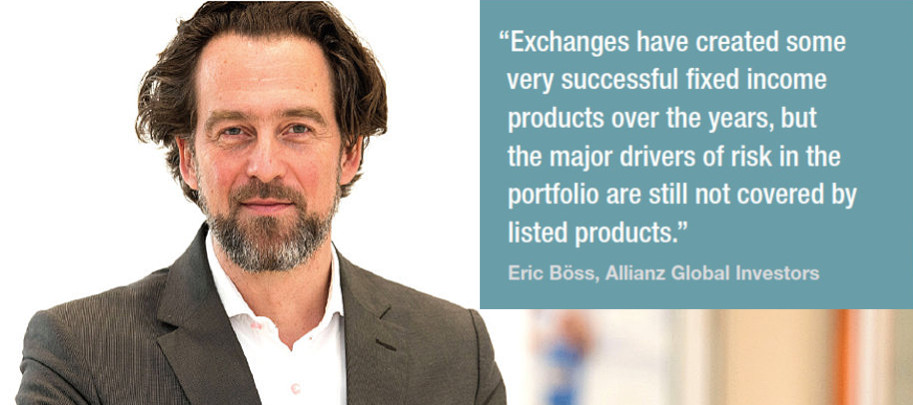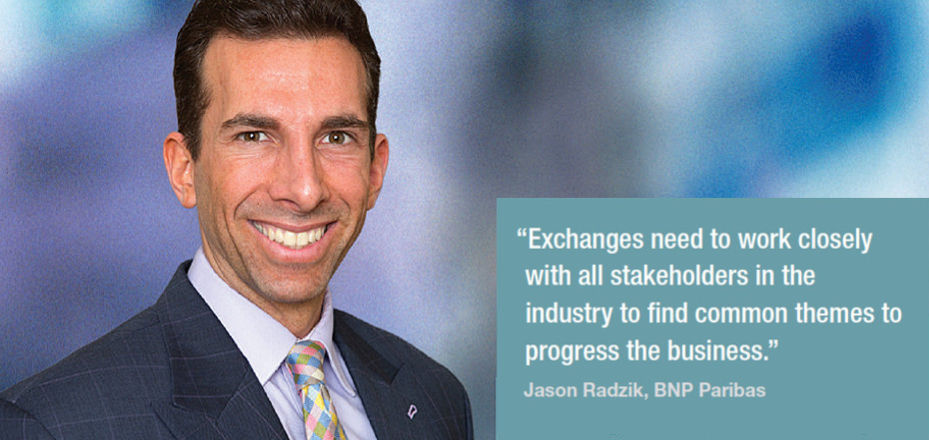Why listed derivatives struggle to address risk
Some traders have been critical of listed products designed to replicate OTC derivatives, but exchanges are working hard to develop appropriate listed instruments. Joel Clark reports.
Why would a buy-side firm want to trade an over-the-counter (OTC) instrument, with all its associated costs, if the same risk exposure could be obtained in a cheaper and more standardised format through a listed product? Exchange-traded alternatives to OTC products offer the potential to free up significant amounts of margin and capital while also opening up access to a broader investor base.
Yet in spite of these advantages, some buy-side firms remain frustrated with what they see as the slow pace of successful product innovation among the main exchanges. Despite vastly increased central clearing of interest rate and credit derivatives in recent years – driven by regulatory mandates – a full transition into listed products appears to be tougher to bring to reality.

“Exchanges have created some very successful fixed income products over the years, but the major drivers of risk in the portfolio – including different types of credit and sector exposure – are still not covered by listed products,” says Eric Böss, global head of trading at Allianz Global Investors (AGI). “I would like to see more liquid and accessible instruments available on exchange, with a diverse ecosystem of liquidity providers and investors.”

Jason Radzik, head of Americas derivatives execution and clearing at BNP Paribas, is similarly ambivalent, noting that despite some early success with the launch of interest rate swap futures, the drive to bring other OTC products onto exchange appears to have stalled.
“The momentum to move from bilateral to listed fixed income products has plateaued and while there is still demand, it becomes more difficult when you get to the esoteric products. There are many more intricacies in how those products are processed and risk managed, which has slowed things down,” Radzik explains.
It has now been several years since the first swap futures became available, typically designed to combine the economic structure of an OTC swap with the flexibility and lower cost of a future. Among the early proponents were Eris Exchange, Intercontinental Exchange, CME Group and Eurex.
Swap futures have remained a popular product, with open interest in Eris US dollar interest rate swap futures rising to nearly 210,000 contracts this year. The product appears to have become a viable and efficient alternative to the traditional OTC market. On 11 May, 2018 CME Group and Eris Exchange announced a licensing agreement to migrate Eris USD Interest Rate Swap Futures to CME Group and the CME Globex trading platform in Q4 2018. This ought to deliver margin offsets for users, given some 30 million contracts of USD interest rate futures open interest are held at CME Clearing.

“Eris swap futures are convexity neutral with OTC swaps, meaning the implied cashflows of Eris are the same as if the transaction had been an OTC swap. This allows users to benefit from the protection, cost and operational advantages of exchange trading without having to compromise on what would be achieved bilaterally, or with a cleared OTC swap,” says Geoffrey Sharp, head of sales at Eris Exchange.
Given the success of swap futures, exchanges have naturally been keen to expand this product push and look to bring other OTC structures onto exchange. Eurex, for example, has been particularly active in product innovation in recent years, with recent launches in late 2017 including exchange traded fund (ETF) options and Italian Government Bond (BTP) options. Average daily volume (ADV) in ETF options has surpassed 400 contracts this year, while for BTP options, ADV since launch is now 2,500 contracts.

Lee Bartholomew, head of fixed income product research and development at Eurex, believes the implementation of the second Markets in Financial Instruments Directive (MiFID II) in January 2018 created added impetus for market participants to consider listed alternatives wherever possible.
“MiFID II and the drive for best execution is pushing the buy side more towards listed solutions, and we see this as a major growth opportunity for Eurex,” he says. “Among OTC instruments, credit and fixed income ETFs are areas where Eurex has developed listed solutions and there is growing demand among real money investors and hedge funds.”
He adds: “We have had a very busy year in listed products with new launches including BTP options, OAT options, fixed income ETF options and corporate bond index futures, but the challenge is not so much in launching a new product but rather in attracting participants and building liquidity.”
It may be too soon to know whether adoption of such products will accelerate, but traders are clear that they must be developed in close collaboration with the industry. Some believe there is a greater role to be played by industry bodies in bringing participants together to determine the most appropriate listed solutions for different user groups.
“Exchanges can do a lot of work to bring new products to market, but if they don’t put themselves in the position of the executing brokers, futures commission merchant (FCMs) and buy-side clients to properly understand their concerns and challenges, they can’t be sure of success. They need to work closely with all stakeholders in the industry to find common themes to progress the business,” says Radzik of BNP Paribas.
It is a prescient warning for exchanges of the need to be clear on the target user base for any new product and ensure that user base is consulted as broadly as possible to determine product suitability. For its part, Eris Exchange believes the need for listed alternatives to OTC products is most acute on the buy side.
“Over time we anticipate dealers will become active participants and recognise the benefits of Eris futures, but we are primarily focused on the buy side community at this stage. OTC swaps serve big players well, albeit for a higher overall cost, so we target firms that get immediate economic benefit from the product,” explains Sharp.
“We have to get to a certain critical mass to attract the larger participants and our biggest challenge is not necessarily finding users, but rather finding users with all of the pipes and plumbing that is needed to access the contract and process it through their internal systems.”
At Eurex, officials acknowledge that listed products won’t ever replace the OTC market, and there will always be a need for those bespoke hedging solutions that can only be structured on a bilateral basis. But given the significant pressures on the buy side, there is still ground to be gained in the listed space.
“Generating target returns is becoming more difficult for portfolio managers because of the rising costs of capital and margin pressures and this plays to the greater standardisation of OTC products, including credit. Exchanges have historically focused mostly on rates within the fixed income space, but as the market evolves it is important that we consider alternative products in this area as well, like ETF options,” says Bartholomew.
The efforts of Eurex, Eris and other exchanges have not gone unnoticed by the buy side, but there remains some disappointment at the slow pace of change. Böss of AGI welcomes product innovation, but believes more could be done to bring liquid instruments onto exchange.
“Some exchanges have been creative in structuring new products rather than simply trying to bring an OTC product directly onto exchange, but there needs to be thorough due diligence in advance. In some cases, the listed products are still too complicated for exchange trading, while sometimes institutional investors already have access to liquid and efficient swap markets so there is less incentive to move to listed,” says Böss.
©Markets Media Europe 2025













